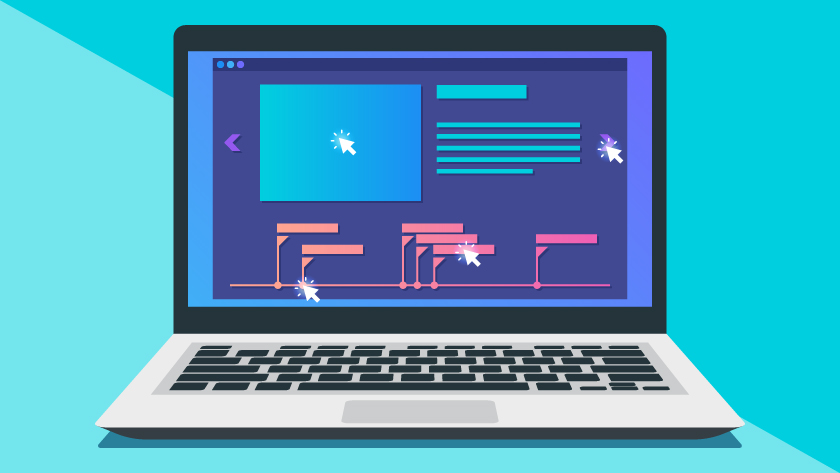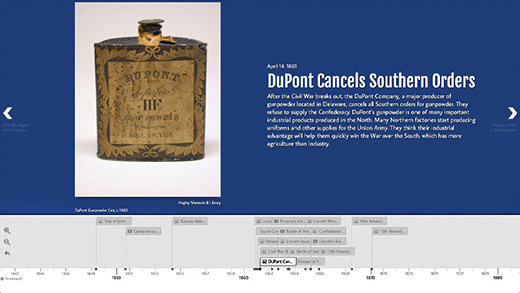
Creating Digital Projects for the Virtual Classroom
Article by Allison Ebner | Illustration by Jaynell Keely
When cultural institutions closed in the wake of the COVID-19 pandemic, museums around the world had to reimagine how people could engage with the history and culture in their collections.
At the University of Delaware, students in the Museum Studies Program learn about the challenges these organizations face in the 21st century and develop the necessary skills to tackle them, which now, more than ever, includes remote and digital learning.
Last fall, Professor Lois Stoehr and the students in her Museum Education and Interpretation course faced this challenge head on. In previous semesters, students would develop lessons and programs for school-aged and adult visitors to interact with materials at area museums. In 2020, with field trips no longer a possibility, the focus of the course shifted to creating digital teaching materials that teachers in local Delaware schools could use in their virtual classrooms.
To do this, Professor Stoehr connected with the Digital Scholarship and Publishing Department at the Library, Museums and Press.
Librarians Kayla Abner and Paige Morgan worked closely with Professor Stoehr to create an assignment that would yield engaging and accessible learning tools for local Delaware teachers while providing students in the course with valuable experience in the field.
The result? Students worked in groups to create digital timelines that pulled together multiple resources—think text, images, multimedia and other data—into a singular interactive learning object. These visually engaging timelines created an easy and dynamic learning experience for, in this case, K-12 students in the Red Clay Consolidated School District.
“Often, it is hard for students to understand the context of a given time period or event, and [providing] information in a digital format that allows information to be presented in print, pictures and videos will be very engaging to our students,” Holly Golder, supervisor of social studies for Red Clay Consolidated School District, explained. “The digital timelines will [also] allow Delaware students to practice identifying trends, such as continuity and change over time, which are assessed on our state tests.”
The topics for these timelines were determined by local social studies teachers. Two groups of students worked closely with the New Castle Historical Society to build digital timelines around New Castle history and the architecture of New Castle. Another group used materials from the Delaware Historical Society to provide insight on the African American experience in Delaware; and other groups created timelines highlighting Delaware’s role in the Revolutionary War and the Civil War.
The project built on knowledge the students were actively learning in the course and the overall program. “We relied on the students’ knowledge of writing labels for exhibitions and communicating with audiences,” Kayla said. “That’s background knowledge and expertise that they have, so we tried to leverage that when we were talking to them about how to make good timelines.”
As aspiring museum professionals, Museum Studies students are well versed in helping others engage with and understand history and culture. But for many, doing this in the digital realm was new and a bit daunting.
While the Timeline JS platform introduces the possibilities of digital humanities in a user-friendly format, digital projects often produce anxiety among both students and faculty when they first encounter them. Digital publishing librarians, like Kayla and Paige, are there to help make everyone feel comfortable working in the digital space.
Professor Stoehr was excited to incorporate a digital project into her syllabus, but it was the first time she was doing so. Wanting to ensure her students received a good learning experience and a fair evaluation, Professor Stoehr consulted Kayla and Paige to create the assignment and grading rubric. Kayla also helped grade the projects and provide specific feedback.
“I think that’s where a lot of instructors get tripped up,” Kayla said. “They don’t want to try digital projects because they haven’t done them before. Just as the students don’t know how to do them, the instructors aren’t familiar with them. They don’t know how to grade them. So it’s helpful when we, as librarians, can guide them in that.”
Kayla helped students in the course feel similarly empowered and confident throughout the assignment.
She hosted several workshop sessions with students to teach them the logistical and mechanical aspects of the Timeline JS platform. After hearing students felt uncomfortable with HTML, which they had to use to create their timelines, Kayla created a basic HTML help sheet to guide the students. She helped when they encountered roadblocks with integrating media into the platform. As the students explored this new platform and built their own learning tools from the ground up, Kayla was there to alleviate concerns and guide them to the next steps.
“Kayla was just as importantly the moral support throughout the project,” Professor Stoehr said. “She was the one I went to saying, ‘Alright, I’m hearing the students say these are the sorts of challenges they’re experiencing,’ and Kayla was really great at breaking those things down into manageable pieces. She would say, ‘I understand why this is a concern, so maybe we go about it this way, or maybe we figure out a slightly different way of doing things.’”
Professor Stoehr will be the first to admit that neither she nor her students knew exactly what to expect from the final projects, but with the guidance of Kayla and the Digital Scholarship and Publishing Department, they were able to produce valuable online learning tools for local Delaware students.
As museums continue to embrace the digital sphere, Professor Stoehr and her students are now more confident and comfortable working with digital media and creating interactive digital projects. As the Museum Studies students continue learning how to tackle the unique challenges of cultural institutions, they are now equipped with another tool for telling stories in new and dynamic ways, and engaging audiences with history and culture.
Teaching and Learning Services at the Library, Museums and Press
In academic spaces and beyond, it is essential that students have opportunities to explore how and why information is created and the ways in which information can be thoughtfully and ethically used. At the Library, Museums and Press, we collaborate with faculty to craft hands-on lessons; develop semester-long partnerships that are connected to course goals; and encourage critical engagement with primary sources, multimedia, data and more. Learn more about our Teaching and Learning Services.

